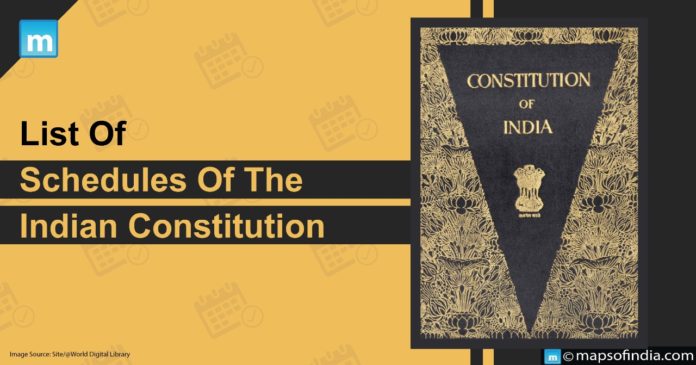- The Indian Constitution contains 12 Schedules. One of the first references to Schedules was in the Government of India Act (GOI Act), 1935, which had ten Schedules.
- When the Constitution of India was enacted in 1949, it had eight Schedules. With the amendments to the Constitution of India, there are now 12 Schedules. This blog offers you an overview of Indian Constitution Schedules.
Let’s talk about each schedule separately:
| Schedules of Indian constitution |
Provisions |
| First Schedule |
- It includes the names of the states and union territories.
- Additionally, states’ territorial jurisdiction is mentioned.
|
| Second Schedule |
The regulations governing the allowances, privileges, and emoluments of the:
- President of India
- Rajya Sabha Chairman and Deputy Rajya Sabha Chairman
- Speaker and Deputy Speaker of the Lok Sabha or the lower house
- Governors of Indian States
- Chairman and Deputy Chairman of Indian States Legislative Councils
- Speaker and Deputy Speaker of Indian State Legislative Assemblies
- Supreme Court Judges
- Judges of the High Court
- Comptroller and Auditor General of India (CAG)
|
| Third Schedule |
It includes oath and affirmation forms for:
- Union Ministers of India
- Parliamentary Members (MPs)
- Candidates for Parliamentary Elections
- Comptroller and Auditor general of India
- Ministers of State
- Members of the State Legislature
- Candidates for the State Legislature Elections
- Judges of the Supreme Court
- Judges of the High Court
|
| Fourth Schedule |
It includes provisions for allocating seats in the Rajya Sabha to states and union territories. |
| Fifth Schedule |
It consists of measures for the administration and governance of Scheduled territories and tribes. |
| Sixth Schedule |
It includes rules for the management of tribal territories in Meghalaya, Tripura, Assam and Mizoram. |
| Seventh Schedule |
This schedule is divided into three legislative lists:
- Union List
- State List
- Concurrent List
|
| Eighth Schedule |
It addresses the Twenty two official languages recognized by the Indian Constitution:
- Bengali
- Bodo
- Assamese
- Gujarat
- Hindi
- Dogri
- Kashmiri
- Konkani
- Kannada
- Malayalam
- Mathili (Maithili)
- Manipuri
- Sindhi
- Marathi
- Nepali
- Oriya
- Punjabi
- Urdu
- Sanskrit
- Tamil
- Santhali
- Telugu
|
| Ninth Schedule |
- It is concerned with governmental legislation and laws dealing with land reforms and the eradication of the zamindari system.
- It also addresses the Parliament’s actions and rules on several topics.
Points to be noted:
- The Ninth schedule got included in list in 1951 by the virtue of first Amendment Act. It basically prevent legislations from judicial examination on the ground of infringement of basic rights.
- However, the Supreme Court declared in 2007 that the statutes included in this schedule following April 24, 1973, are now subject to judicial examination.
|
| Tenth Schedule |
- It includes provisions for the disqualification of representatives of Parliament and state legislatures for secession.
Points to be noted:
- The 52nd Amendment Act of 1985, often known as the Anti-defection Law, included this schedule.
|
| Eleventh Schedule |
- It contains 29 provisions. These provisions specify the powers, authority, and responsibilities of Panchayats.
Point to be noted:
- By virtue of the 73rd Amendment Act of 1992, this schedule was added.
|
| Twelfth Schedule |
- It is concerned with the provisions that define Municipalities’ powers, authority, and obligations. It has 18 provisions.
Points to be note:
- The 74th Amendment Act of 1992 included this schedule.
|




